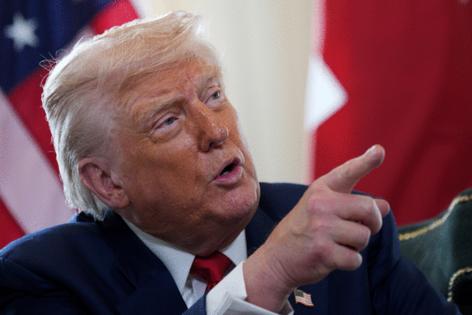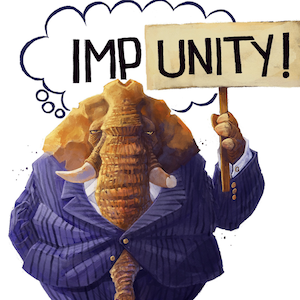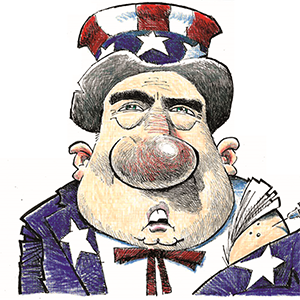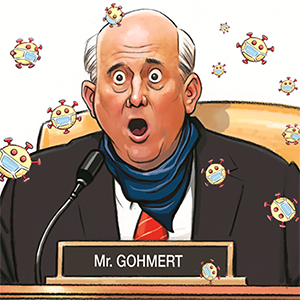A raging Trump digs in on his trade war after brutal jobs report
Published in Political News
WASHINGTON — The Trump administration is doubling down on its trade war against much of the world despite increasingly harrowing economic numbers emerging at home, with stock markets and Treasury yields tumbling Friday on news of the most significant slowdown in job growth since the pandemic.
Government data showed the U.S. economy added 73,000 jobs in July — far fewer than expected — and issued revised numbers for the prior two months that showed only 19,000 jobs were created in May, and 14,000 in June, amid widespread uncertainty over President Trump’s tariff policies and deep cuts to government employment.
The unemployment numbers came a day after Trump signed an executive order increasing tariffs on 66 countries, further roiling a decades-old system of global trade.
The chair of the White House council of economic advisers reacted to the unemployment report by saying the numbers are “not what we want to see.” But Trump responded by directing his team to fire the commissioner of the Bureau of Labor Statistics, a nonpartisan position responsible for overseeing the statistical analysis of jobs data, suggesting the numbers were politically “manipulated.” She was fired hours later.
“I was just informed that our Country’s ‘Jobs Numbers’ are being produced by a Biden Appointee, Dr. Erika McEntarfer, the Commissioner of Labor Statistics, who faked the Jobs Numbers before the Election to try and boost Kamala’s chances of Victory,” Trump wrote on his social media platform, Truth Social.
McEntarfer was confirmed by a Senate vote of 86 to 8 in January 2024. He did not offer evidence to support his accusations of manipulated data, either for this year or before the 2024 election.
“We need accurate Jobs Numbers. I have directed my Team to fire this Biden Political Appointee, IMMEDIATELY. She will be replaced with someone much more competent and qualified. Important numbers like this must be fair and accurate, they can’t be manipulated for political purposes.”
Paradoxically, Trump and his team also seemed to acknowledge the authenticity of the numbers by blaming the chair of the Federal Reserve, Jerome Powell, for the disappointing results.
For months, Powell has resisted pressure from Trump to lower interest rates amid concerns over stubbornly high inflation — and the prospect that prices will increase further if the president’s trade war persists. The Federal Reserve chairmanship is another position meant to operate with independence.
“Inflation has cooled, wages have increased, unemployment is stable, and the private sector is growing,” Karoline Leavitt, the White House press secretary, said in a statement to The Times. “President Trump’s America First agenda has ensured new jobs go to American citizens, instead of illegals or foreign-born workers. The tariffs are raking in billions of dollars to make our country wealthy again. Jerome ‘Too Late’ Powell needs to cut rates so our economy can continue to boom.”
At the closing bell, the Dow Jones industrial average had fallen over 500 points, while the NASDAQ was down over 2.25%. The U.S. dollar fell against other currencies. But the most telling moves may have occurred in the bond market, which saw the most drastic slumps in 10-year and two-year Treasury yields in a year.
The increased unemployment rate, to 4.2%, came off government data reported earlier in the week that showed a dramatic decrease in imports and consumer demand to the United States, figures that have temporarily inflated economic growth numbers. Overall, economists are warning that U.S. gross domestic product could grow less than 2% this year, its worst performance since the height of the pandemic.
Trump has had issues with unemployment data for many years, often using one of his favorite terms, “fake,” to describe them. During his 2016 campaign, he argued that unemployment was worse than the government figures showed; once in the White House, he suggested the official data understated the strength of the economy.
The timing of the latest jobs report comes at a politically inopportune moment for Trump, who had set Friday as a deadline for countries around the world to negotiate trade deals with the United States on his terms, or else face steep tariff rates.
Only a handful of framework agreements were struck — with the European Union, South Korea, Japan, the United Kingdom and Vietnam, among others — while dozens of other nations were hit with rate hikes. Major trading partners faced brutal increases, including Brazil, which now faces a 50% rate on most goods, and India, hit with 25% import duties.
Switzerland was slammed with a 39% rate, but most countries on the list released by the White House were given 15% tariff rates. The new import taxes are to take effect Aug. 7.
Economists have warned since April 2, when Trump declared “Liberation Day” from a global system of free trade, that his new policies would devastate the U.S. economy, raising prices and slowing growth in the short term while depressing living standards for years to come.
“The good news,” Trump wrote on Friday, “is that Tariffs are bringing Billions of Dollars into the USA!”
Tariff discussions remain unresolved for Canada and Mexico, two of the United States’ largest trading partners. Though Trump said this week that Friday was a firm deadline and would not be extended, on Thursday he said new tariffs on some Mexican goods would be delayed 90 days while the two countries continue to negotiate.
Canada, on the other hand, remains at an impasse with the president over his demands.
“We will continue to negotiate with the United States on our trading relationship,” Mark Carney, Canada’s prime minister, said in a statement, but, “the Canadian government is laser focused on what we can control: building Canada strong.”
“We can give ourselves more than any foreign government can ever take away,” he added.
©2025 Los Angeles Times. Visit at latimes.com. Distributed by Tribune Content Agency, LLC.

























































Comments